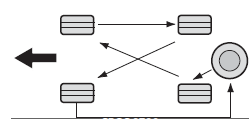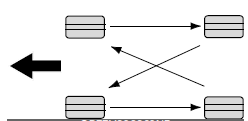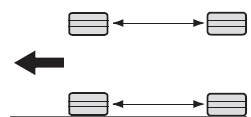Kia Sportage: Checking tire inflation pressure
Check your tires once a month or more.
Use a good quality gauge to check tire pressure. You cannot tell if your tires are properly inflated simply by looking at them. Radial tires may look properly inflated even when they're underinflated.
Check the tire's inflation pressure when the tires are cold. "Cold" means your vehicle has been sitting or at least three hours or driven no more than 1 mile (1.6 km).
- Remove the valve cap from the tire valve stem.
- Press the tire gauge firmly onto
the valve to get a pressure measurement.
If the cold tire inflation pressure matches the proper pressure on the tire and loading information label, no further adjustment is necessary.
- If the pressure is low, add air until you reach the recommended amount.
- If you overfill the tire, release air by pushing on the metal stem in the center of the tire valve.
- Recheck the tire pressure with the tire gauge.
- Be sure to put the valve caps back on the valve stems. They help prevent leaks by keeping out dirt and moisture.
Inspect your tires frequently for proper inflation as well as wear and damage. Always use a tire pressure gauge.
Tires with too much or too little pressure wear unevenly. This could result in poor handling, loss of vehicle control, and sudden tire failure leading to accidents, injuries, and even death. The recommended cold tire pressure for your vehicle can be found in this manual and on the tire label located on the driver's side center pillar.
Tire rotation
To equalize tread wear, it is recommended that the tires be rotated every 8,000 miles (13,000 km) or sooner if irregular wear develops.
During rotation, check the tires for correct balance.
When rotating tires, check for uneven wear and damage. Abnormal wear is usually caused by incorrect tire pressure, improper wheel alignment, out of-balance wheels, severe braking or severe cornering.
Look for bumps or bulges in the tread or side of tire. Replace the tire if you find either of these conditions.
Replace the tire if fabric or cord is visible. After rotation, be sure to bring the front and rear tire pressures pressures to specification and check lug nut tightness. (proper torque is 79 ~ 94 lbf*ft [11 ~ 13 kgf*m]) Refer to "Tires and wheels.
Disc brake pads should be inspected for wear whenever tires are rotated.
With a full-size spare tire (if
equipped) 
Without a spare tire

Directional tires (if equipped)

Rotate radial tires that have an asymmetric tread pattern only from front to rear and not from right to left.
WARNING
Mixing tires
Do not mix bias ply and radial ply tires under any circumstances. This may cause unusual handling characteristics.
READ NEXT:
 Wheel alignment and tire balance
Wheel alignment and tire balance
The wheels on your vehicle were
aligned and balanced carefully at
the factory to give you the longest
tire life and best overall performance.
If you notice unusual tire wear or
your vehicle pul
 Tire sidewall labeling
Tire sidewall labeling
This information identifies and
describes the fundamental characteristics
of the tire and also provides
the Tire Identification Number (TIN)
for safety standard certification.
The TIN can be
 Tire terminology and definitions
Tire terminology and definitions
Refer to the following for detailed
definitions of the terms that are
found in the tire description.
Air Pressure The amount of air
inside the tire pressing outward on
the tire. Air pressure is
SEE MORE:
 Components and Components Location | Steering Column and Shaft
Components and Components Location | Steering Column and Shaft
Components
Steering wheel
Steering column
ECU
Motor
Steering gear box
MDPS Circuit Diagram
Harness Connector
Battery
Battery -
Battery +
Vehicle
IGN
-
-
 EBD (Electronic Brake-force Distribution) | ESC Control Module
EBD (Electronic Brake-force Distribution) | ESC Control Module
Description and Operation
Operation
The EBD system (Electronic Brake force Distribution) as a sub-system of the ABS system is to control the maximum braking effectiveness by the rear wheels.
It further utilizes the efficiency of highly developed ABS equipment by controlling the slip of th
Content
- Home
- Kia Sportage - Fifth generation (NQ5) - (2022-2026) - Owner's Manual
- Kia Sportage - Second generation (JEKM) (2005-2015) - Body Workshop Manual
- Kia Sportage Third generation (SL) - (2011-2016) - Service and Repair Manual
- Sitemap
- Top articles